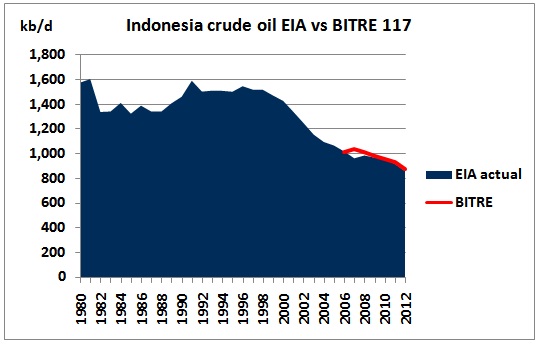1 year ago the Australian Federal Government refused to table their internal peak oil report BITRE 117 before a Senate hearing on the grounds that the report was not “up to scratch”. The 2012 energy white paper failed to come up with an updated version so this research has been abandoned. However, it is very important to know where we are. Therefore, let’s have a look how good the BITRE forecast was which started in 2007, giving us 6 years of comparison with actual crude production data from EIA.
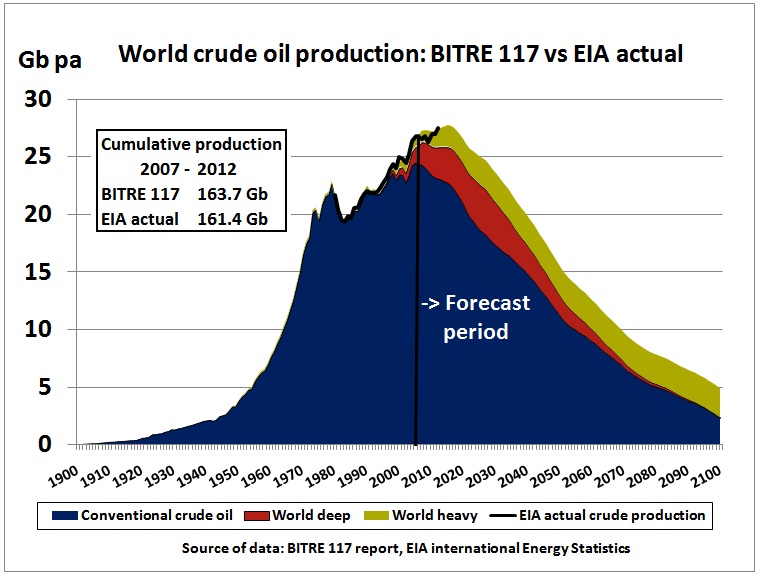 This post makes visible the plus and minus hidden in what looks like a quite good forecast, given all the uncertainties. Actual production (black curve) in 2012 was slightly higher but cumulative production for the whole period 2007-2012 was slightly lower.
This post makes visible the plus and minus hidden in what looks like a quite good forecast, given all the uncertainties. Actual production (black curve) in 2012 was slightly higher but cumulative production for the whole period 2007-2012 was slightly lower.
Methodology and graphs
In part 1 of this analysis we superimpose the BITRE forecast (as a red line from 2007) on actual crude production graphs with data from the EIA
www.eia.gov/cfapps/ipdbproject/iedindex3.cfm?
(1) Middle East (BITRE chapters 9 and 10)
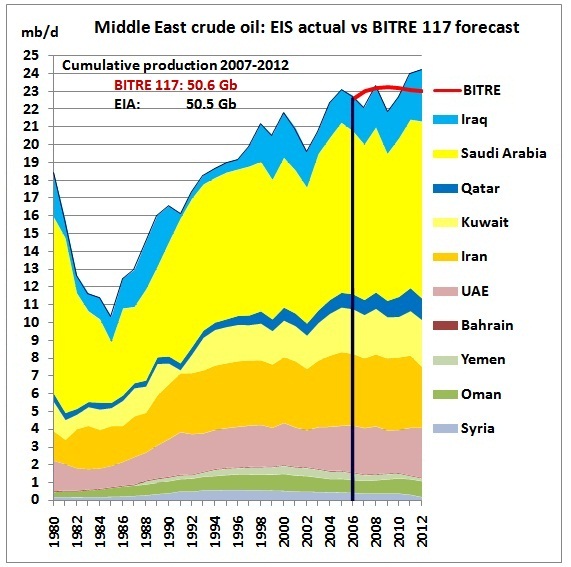 The red line is BITRE’s 5-year smoothed forecast. Actual annual production in 2012 was 1.2 mb/d higher than the forecast mainly resulting from an increase in Iraqi oil production. But when looking at cumulative production since 2007 there is practically no difference because of Saudi production drops in 2007 (genuine decline) and 2009 (swing producer response to a drop in demand as the financial crisis evolved). In fact, when looking at the production profile of around half of the ME oil we see it is peaking since 2005. So everything depends on Iraq. Bush and Cheney – who were oilmen – knew that when invading this country.
The red line is BITRE’s 5-year smoothed forecast. Actual annual production in 2012 was 1.2 mb/d higher than the forecast mainly resulting from an increase in Iraqi oil production. But when looking at cumulative production since 2007 there is practically no difference because of Saudi production drops in 2007 (genuine decline) and 2009 (swing producer response to a drop in demand as the financial crisis evolved). In fact, when looking at the production profile of around half of the ME oil we see it is peaking since 2005. So everything depends on Iraq. Bush and Cheney – who were oilmen – knew that when invading this country.
(2) North America (BITRE chapter 3)
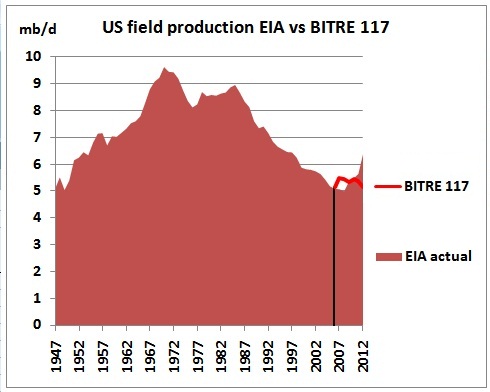 EIA data from: http://www.eia.gov/dnav/pet/hist/LeafHandler.ashx?n=PET&s=MCRFPUS2&f=A
EIA data from: http://www.eia.gov/dnav/pet/hist/LeafHandler.ashx?n=PET&s=MCRFPUS2&f=A
BITRE 117 could not foresee tight oil in the US where actual production in 2012 was 1.2 mb/d higher than forecast.
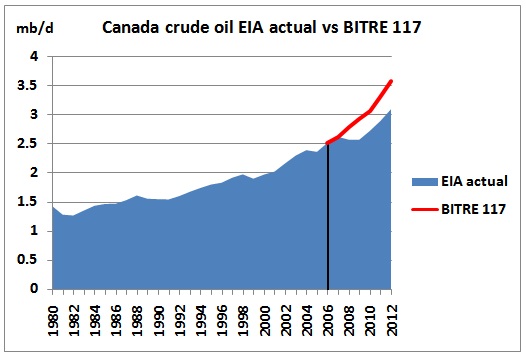 BITRE 117 over-estimated syn-crude from tar sands by 0.5 mb/d for 2012.
BITRE 117 over-estimated syn-crude from tar sands by 0.5 mb/d for 2012.
EIA data from:
http://www.eia.gov/cfapps/ipdbproject/iedindex3.cfm?tid=5&pid=57&aid=1&cid=CA,&syid=1980&eyid=2011&unit=TBPD
US and Canada together (BITRE puts Mexico under Latin America)
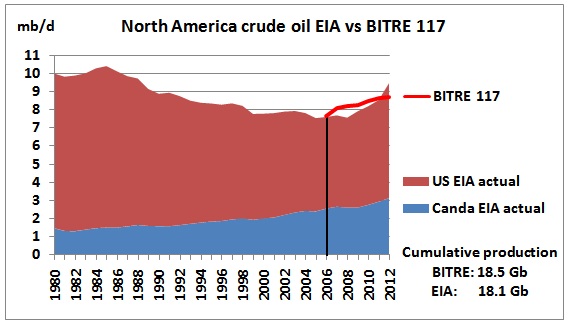 We see that actual crude production in 2012 was higher than estimated by BITRE, although actual cumulative production over the period 2007-2012 was slightly lower.
We see that actual crude production in 2012 was higher than estimated by BITRE, although actual cumulative production over the period 2007-2012 was slightly lower.
US outlook: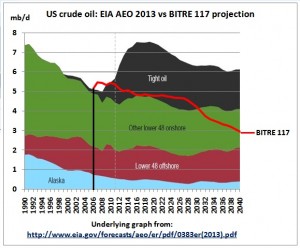 When comparing projections from the early release of the EIA Annual Energy Outlook 2013 and BITRE 117 it is clear that BITRE underestimated US production, mainly from tight oil (shale oil) by around 2 mb/d. However, once tight oil has peaked, EIA and BITRE decline rates are quite similar. Whether EIA’s tight oil projections are correct, is another question. Only time will tell. Those tight oil wells deplete very fast.
When comparing projections from the early release of the EIA Annual Energy Outlook 2013 and BITRE 117 it is clear that BITRE underestimated US production, mainly from tight oil (shale oil) by around 2 mb/d. However, once tight oil has peaked, EIA and BITRE decline rates are quite similar. Whether EIA’s tight oil projections are correct, is another question. Only time will tell. Those tight oil wells deplete very fast.
(3) Latin America (BITRE chapter 4)
 BITRE overestimated Venezuelan extra heavy oil by about 0.6 mb/d
BITRE overestimated Venezuelan extra heavy oil by about 0.6 mb/d
 Mexico, which has definitely peaked, has also been overestimated, by 0.7 mb/d
Mexico, which has definitely peaked, has also been overestimated, by 0.7 mb/d
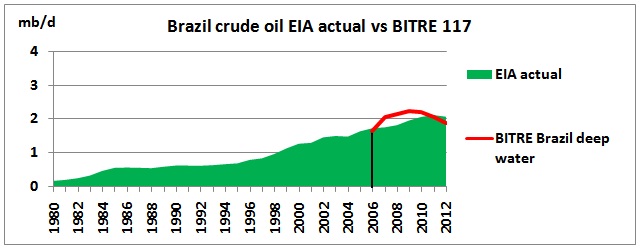 Actual crude production in 2012 is marginally higher than the BITRE estimate but the production profile is different, also in comparison with Petrobras data:
Actual crude production in 2012 is marginally higher than the BITRE estimate but the production profile is different, also in comparison with Petrobras data:
 It seems the BITRE peak from existing fields has been shifted by a couple of years
It seems the BITRE peak from existing fields has been shifted by a couple of years
All Latin American countries including Mexico (which the EIA has under North America):
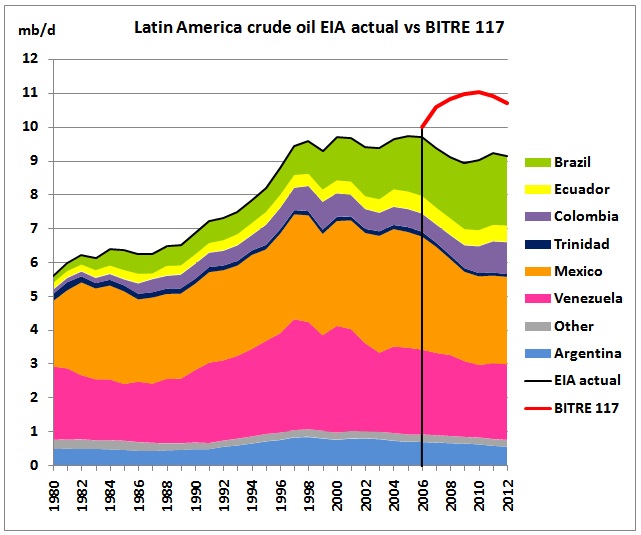 For 2012, BITRE overestimated this group of countries by 1.5 mb/d.
For 2012, BITRE overestimated this group of countries by 1.5 mb/d.
(4) Europe (BITRE chapter 6)
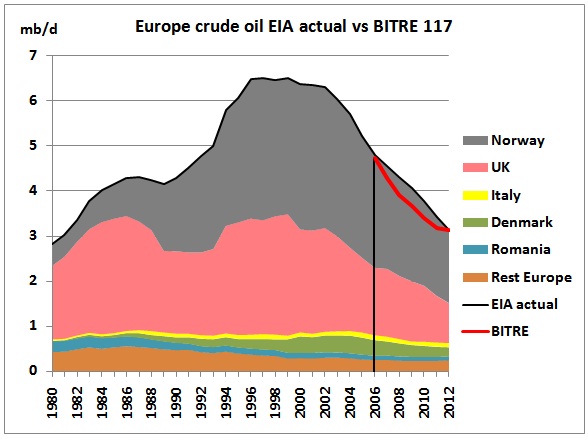 In 2012, EIA actual and BITRE projection were on the same level. Norway’s production was a bit higher than projected.
In 2012, EIA actual and BITRE projection were on the same level. Norway’s production was a bit higher than projected.
(5) Eurasia (BITRE chapter 7 which includes China)
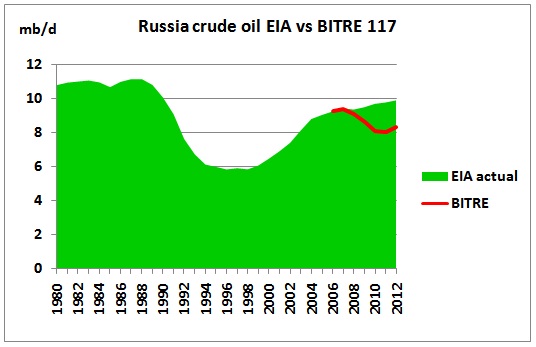 Russia’s 2nd oil peak has been underestimated by 1.6 mb/d for 2012. However, Russian exports have not increased (as shown in JODI data in the previous post). Therefore, global markets have not seen this extra oil.
Russia’s 2nd oil peak has been underestimated by 1.6 mb/d for 2012. However, Russian exports have not increased (as shown in JODI data in the previous post). Therefore, global markets have not seen this extra oil.
 Azerbaijan has been underestimated by 110 kb/d for 2012
Azerbaijan has been underestimated by 110 kb/d for 2012
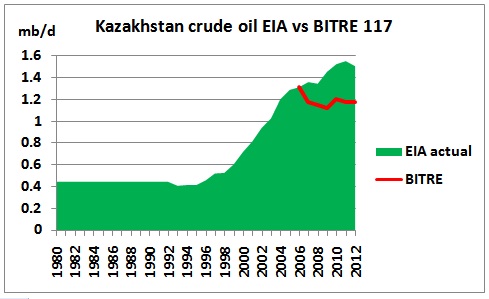 Kazakhstan was underestimated by 330 kb/d for 2012
Kazakhstan was underestimated by 330 kb/d for 2012
 China was underestimated by 1.1 mb/d for 2012. The world markets would not have seen a single drop of that oil, although China’s oil import requirements might have decreased.
China was underestimated by 1.1 mb/d for 2012. The world markets would not have seen a single drop of that oil, although China’s oil import requirements might have decreased.
(6) East (BITRE chapter 8 )
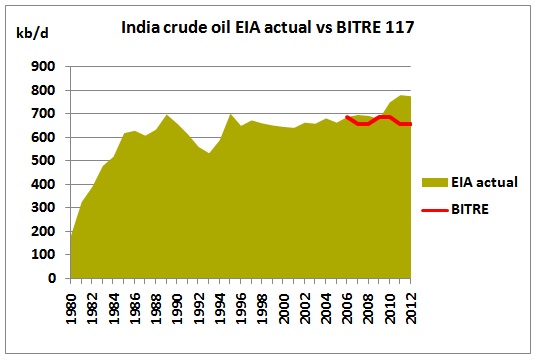 BITRE underestimated by 120 kb/d in 2012
BITRE underestimated by 120 kb/d in 2012
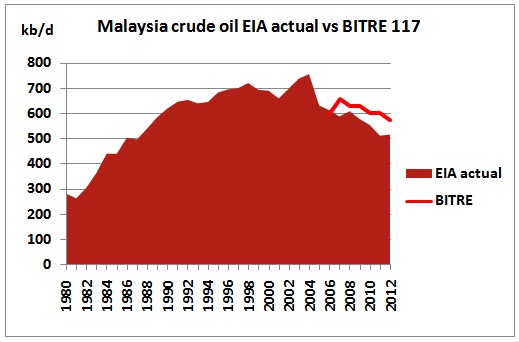 BITRE overestimated by 60 kb/d in 2012
BITRE overestimated by 60 kb/d in 2012
 BITRE overestimated by 40 kb/d in 2012
BITRE overestimated by 40 kb/d in 2012
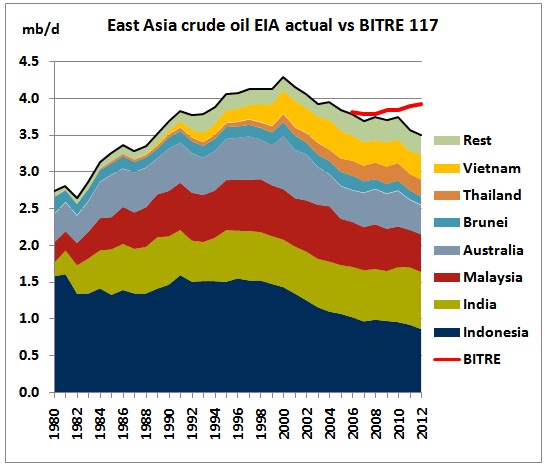 Adding it all up: BITRE over-estimated East Asia by 400 kb/d, mainly from deep water.
Adding it all up: BITRE over-estimated East Asia by 400 kb/d, mainly from deep water.
(7) Africa (BITRE chapter 5)
 For 2012, Nigeria was overestimated by 1.5 mb/d, most of it in deep water
For 2012, Nigeria was overestimated by 1.5 mb/d, most of it in deep water
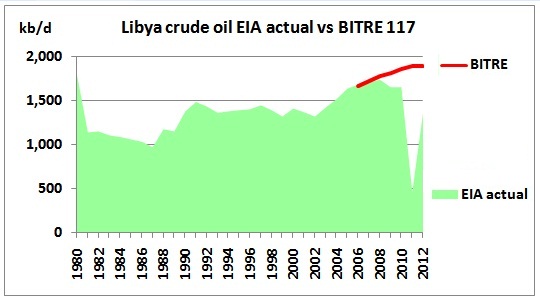 In Libya, production was impacted by the war in 2011, so BITRE’s estimate for 2012 was 500 kb/d higher. Without the war, the estimate would probably have been only 200 kb/d higher.
In Libya, production was impacted by the war in 2011, so BITRE’s estimate for 2012 was 500 kb/d higher. Without the war, the estimate would probably have been only 200 kb/d higher.
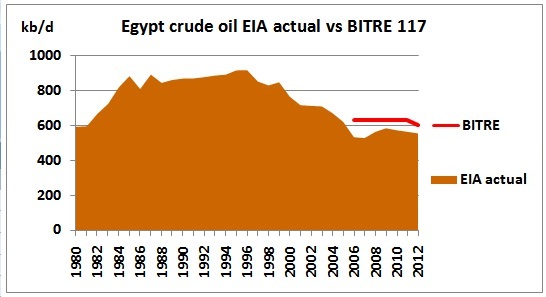 Egypt in 2012 was overestimated by 50 kb/d
Egypt in 2012 was overestimated by 50 kb/d
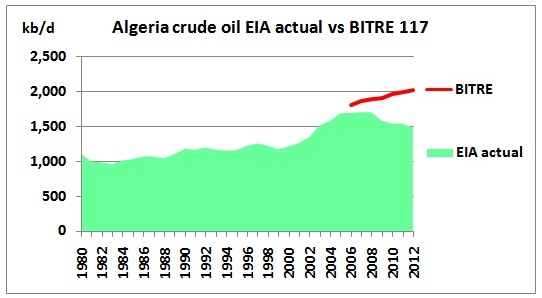 Algeria was overestimated by 0.5 mb/d in 2012
Algeria was overestimated by 0.5 mb/d in 2012
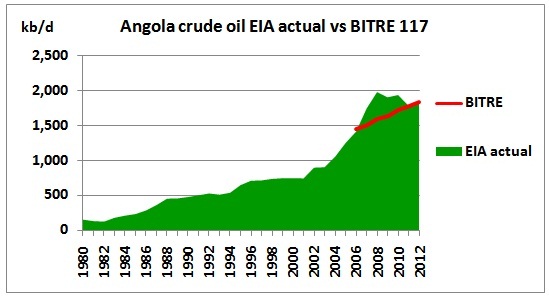 Angola was spot on for 2012 although actual cumulative production was higher
Angola was spot on for 2012 although actual cumulative production was higher
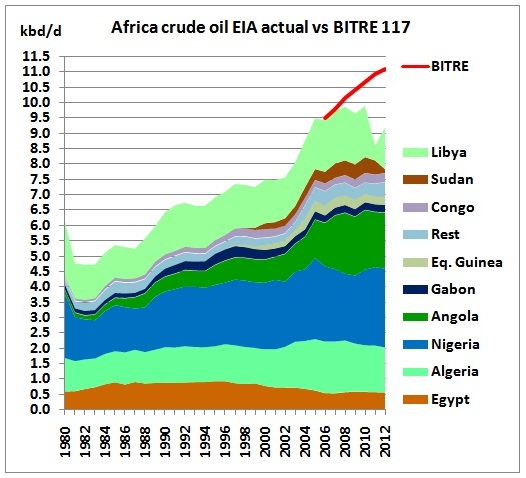 On balance, Africa was clearly overestimated, by 1.9 mb/d in 2012 out of which 0.3 mb/d was as a result of the war in Libya.
On balance, Africa was clearly overestimated, by 1.9 mb/d in 2012 out of which 0.3 mb/d was as a result of the war in Libya.
(8) Comparing Plus and Minus
As we can see, there is a lot of plus and minus which is normal for estimates.
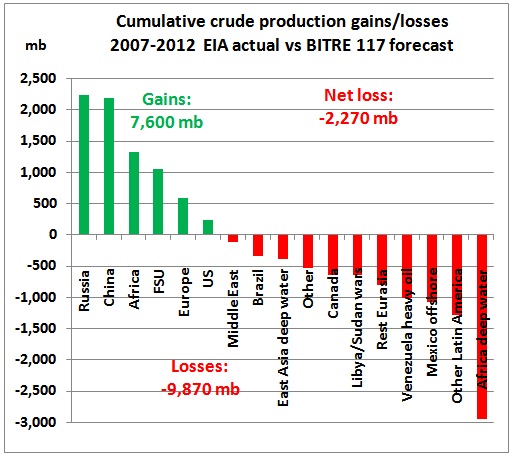 This graph shows the cumulative crude oil production differences for 2007-2012 between BITRE’s original forecast and actual crude production. The green (red) columns on the left (right) represent actual production higher (lower) than the forecast.
This graph shows the cumulative crude oil production differences for 2007-2012 between BITRE’s original forecast and actual crude production. The green (red) columns on the left (right) represent actual production higher (lower) than the forecast.
Actual cumulative production was 161.4 Gb, less than the forecast of 163.7 Gb, a very small difference of 1%, well within the accuracy limits of such forecasts. However, when looking at total losses we get 9.87/163.7 = 6 % so the variance is higher.
What is more important is where the changes have taken place, and what the trends have been over time. We can distinguish following groups:
(8.1) Actual crude production higher than forecast
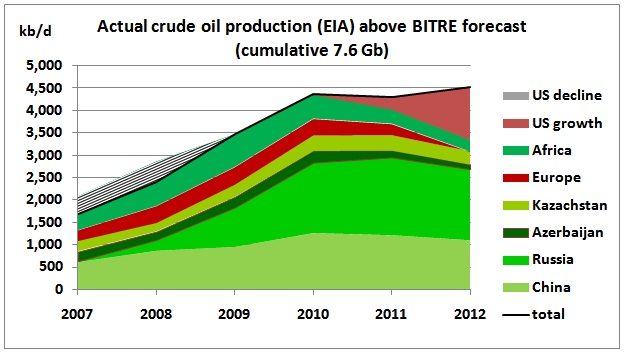 These are all the countries with gains over BITRE’s forecast. We can see that additional production has reached a plateau at around 4.5 mb/d but only due to US shale oil (tight oil) while all other countries have peaked at 4.4 mb/d and declined since then to 3.3 mb/d in 2012. This means that the future will depend on whether the US can offset decline in the rest of the group which BITRE under-estimated. The hatched area is an initial period of US decline.
These are all the countries with gains over BITRE’s forecast. We can see that additional production has reached a plateau at around 4.5 mb/d but only due to US shale oil (tight oil) while all other countries have peaked at 4.4 mb/d and declined since then to 3.3 mb/d in 2012. This means that the future will depend on whether the US can offset decline in the rest of the group which BITRE under-estimated. The hatched area is an initial period of US decline.
As already mentioned Russia’s additional oil has not helped the global oil markets. China’s additional oil was consumed domestically but may have reduced import requirements. What the world gained from this group are exports from Kazakhstan, Azerbaijan and Angola which went up by around 500 kb/d over the period 2007-2012.
(8.2) Actual crude production lower than forecast – declining trend
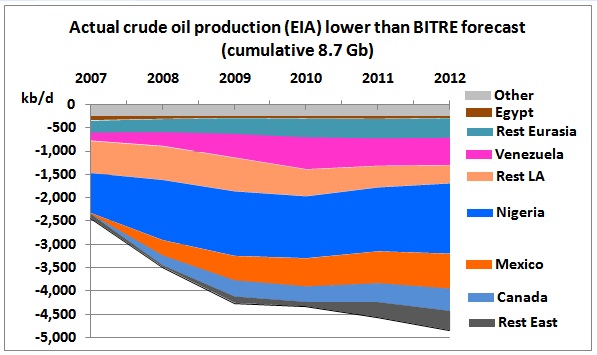 On the other side of the equation we have losses compared to BITRE’s forecast, mainly from Nigeria’s expected deep water bonanza, Venezuela’s heavy oil, Mexico offshore, Canadian tar sands and Latin America (incl. Argentina, Colombia and Ecuador). The below-forecast group still showed an increase of losses in the last years to 4.8 mb/d, mainly from deep water in East Asia not coming on-line as forecast by BITRE, more than cancelling out the gains of 4.5 mb/d under (8.1)
On the other side of the equation we have losses compared to BITRE’s forecast, mainly from Nigeria’s expected deep water bonanza, Venezuela’s heavy oil, Mexico offshore, Canadian tar sands and Latin America (incl. Argentina, Colombia and Ecuador). The below-forecast group still showed an increase of losses in the last years to 4.8 mb/d, mainly from deep water in East Asia not coming on-line as forecast by BITRE, more than cancelling out the gains of 4.5 mb/d under (8.1)
(8.3) Actual crude production lower than forecast – mixed bag
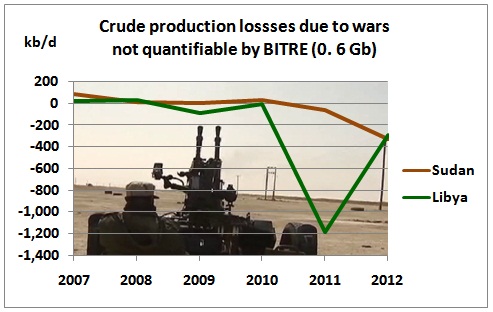 Oil wars, oil-proxy-wars and civil wars about oil are difficult to “forecast”, although future oil wars are entirely foreseeable – without, however, knowing exactly where the bombs will go off. Reduced oil production from wars and social unrest are part of negative feed-back loops characteristic for the process of peaking oil production.
Oil wars, oil-proxy-wars and civil wars about oil are difficult to “forecast”, although future oil wars are entirely foreseeable – without, however, knowing exactly where the bombs will go off. Reduced oil production from wars and social unrest are part of negative feed-back loops characteristic for the process of peaking oil production.
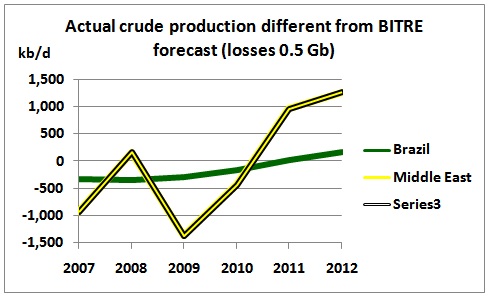 Amazingly, these diverse regions together lost a cumulative 500 mb compared to the BITRE forecast. They appear in this graph because they don’t fit into any other previous graph. One cannot stack both negative and positive areas. As already mentioned, lower than forecast Middle East production in 2007 was caused by Saudi Arabia (twilight in the desert). The reduction in 2009/2010 (swing role) followed the financial crisis which was triggered by high oil prices as a result of peak oil starting in 2005. Brazil’s offshore (90% of oil) also performed less than expected, although production is finally slightly above BITRE’s forecast. In any case, Brazil’s exports have not increased in the last 4 years so world markets did not benefit.
Amazingly, these diverse regions together lost a cumulative 500 mb compared to the BITRE forecast. They appear in this graph because they don’t fit into any other previous graph. One cannot stack both negative and positive areas. As already mentioned, lower than forecast Middle East production in 2007 was caused by Saudi Arabia (twilight in the desert). The reduction in 2009/2010 (swing role) followed the financial crisis which was triggered by high oil prices as a result of peak oil starting in 2005. Brazil’s offshore (90% of oil) also performed less than expected, although production is finally slightly above BITRE’s forecast. In any case, Brazil’s exports have not increased in the last 4 years so world markets did not benefit.
Summary:
FSU countries and China performed much better than forecast. Growing US tight oil production was not foreseeable at the time of the forecast although additional cumulative production from this unconventional oil did not play a big role in the period under consideration. On the down side, deep water oil from Nigeria, offshore oil from Mexico and unconventional oil from Venezuela and Canada did not materialize as forecast, suggesting that the underlying conventional oil peak will ultimately dominate future decline.
In the next post we’ll have a look at how current trends compare with BITRE estimates up to 2020, region by region.
Web links:
The BITRE 117 report can be downloaded here:
https://jancovici.com/wp-content/uploads/2016/04/Australian_Govt_Oil_supply_trends.pdf
Note: the original link to Ian McPherson’s website no longer works. RIP
Previous peaky leaks posts:
24/2/2012
Australian Government kicks own goals in Senate peak oil debate (peaky leaks part 3)
http://crudeoilpeak.info/australian-government-kicks-own-goals-in-senate-peak-oil-debate-peaky-leaks-part-3
5/2/2012 Australian peak oil report ignored for urgent Sydney Canberra rail upgrade (peaky leaks Part 2)
http://crudeoilpeak.info/australian-peak-oil-report-ignored-for-urgent-sydney-canberra-rail-upgrade-peaky-leaks-part2
20/1/2012 Australian Peaky Leaks goes mainstream (peaky leaks part 1)
http://crudeoilpeak.info/australian-peaky-leaks-goes-mainstream
